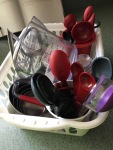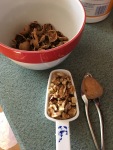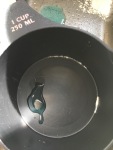
When you manage food allergies as the CCO of the household (Chief Cooking Officer), cross contamination is a real risk. Did you double-dip the measuring spoon in an allergen previously? Are there traces left from the last thing you baked, on your bakeware? The list goes on and on.
Now that my children have passed a couple of tree nut challenges — details on what led to this here – we need to incorporate nuts into their diets regularly.
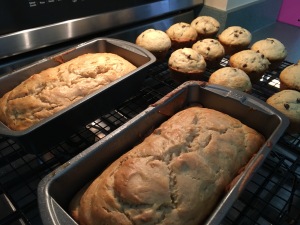 The sticky one to manage has been walnut. The older kid is cleared to eat them, the younger one, not yet.
The sticky one to manage has been walnut. The older kid is cleared to eat them, the younger one, not yet.
I had an extra bunch of bananas so started off Sunday with a quick batch of Banana Chocolate Chip muffins – dairy, egg, peanut & tree nut free. (Note: I am a big fan of the Food Allergy Mama cookbooks)
I then delved into making a batch of Banana Bread...with Walnuts. The original recipe did not have walnuts, but my older kid needs to eat them.
Note: While one of my children CAN eat peanuts, due to the level of the other child’s allergy, we do NOT have any peanut products in the house. This was our personal choice for our situation. Consider your own children’s allergies, ease of clean-up, and what your allergist advises, when making a decision like this.
Here’s How I Manage Contamination when Baking:
(Disclaimer: This is based on my experience – your mileage in your own kitchen may vary.)
(1) Clean As You Go.
If you can manage the mess, you can successfully segregate any utensils, cookware or appliances where you used the allergen.
(2) Have Lots of Measuring Cups & Spoons
It may be more to store…but it makes the prep so much easier – and safer – when you have clean measuring spoon or cup handy. I keep mine in a basket in my baking cabinet.
(3) Pre-Baking Note on Using Nuts.
Most pre-shelled nuts are run on equipment where other nuts, including peanuts, may have been handled. They usually have huge cross contamination warnings on them for a reason. Especially if your kids haven’t passed all the nut challenges, the safest way to incorporate a single nut, is to crack them yourself.
(4) Isolate the nut cracking.
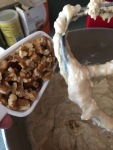 Here’s where it gets tricky. I like to do this in a different area than the general baking prep area.
Here’s where it gets tricky. I like to do this in a different area than the general baking prep area.
Shelling your own walnuts is a PITA. Even with a deep bowl in which to crack the shells, they can – and do – go flying.
Cautionary Tale: I pulled apart my countertop afterwards and found shell fragments everywhere, including in the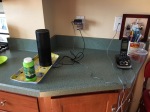 Amazon Echo phone cord. Luckily, all of the stuff on the counter was easily wipeable with Lysol Wipes.
Amazon Echo phone cord. Luckily, all of the stuff on the counter was easily wipeable with Lysol Wipes.
Bonus – removing the dust in the Echo improved the sound quality. (I can hands-free listen to music or books while I bake).
(5) Have dedicated Nut Handling Equipment.
I have one pink-rimmed bowl for nut cracking. Obviously, the nut cracker is dedicated. I wash them and measuring equipment with hot soapy water afterwards.
I do NOT have an extra KitchenAid Mixer bowl and paddle, so I wash them in hot soapy water and sanitize.
I also swap out my dish rag for a clean one after cleaning up an allergen.
(6) When Serving, Contain the Product
For you, this may mean pre-slicing the banana bread with walnuts, and putting into plastic bags for individual servings. Or, if you can manage the crumbs, keep it in a container and slice as you need it.
Because this recipe made two loaves of bread, I’m freezing one to defrost in the future when we’re busy.
(7) Label, Label, Label!!!
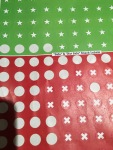 If you freeze a loaf, pre-slice pieces, or just throw it in your fridge – BE SURE TO LABEL. If you have a toddler who cannot eat this – Make sure a sticker is on it and he or she knows it’s NOT safe. Take every precaution needed.
If you freeze a loaf, pre-slice pieces, or just throw it in your fridge – BE SURE TO LABEL. If you have a toddler who cannot eat this – Make sure a sticker is on it and he or she knows it’s NOT safe. Take every precaution needed.
(8) Good luck!
Additional resources:

